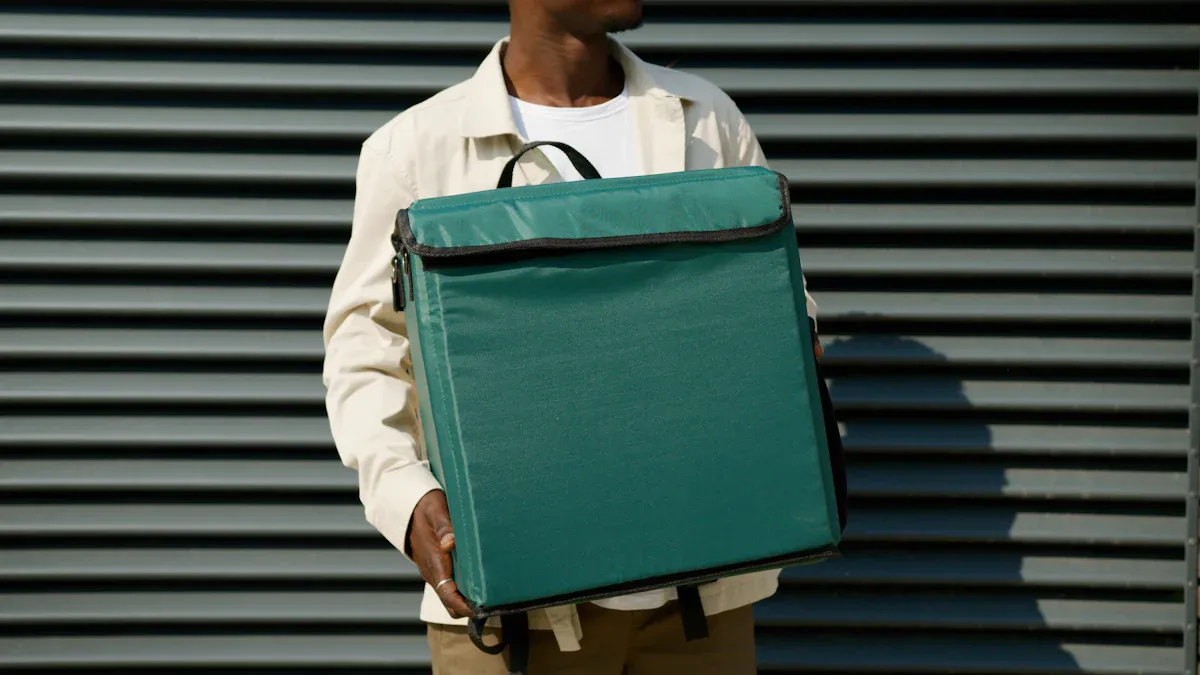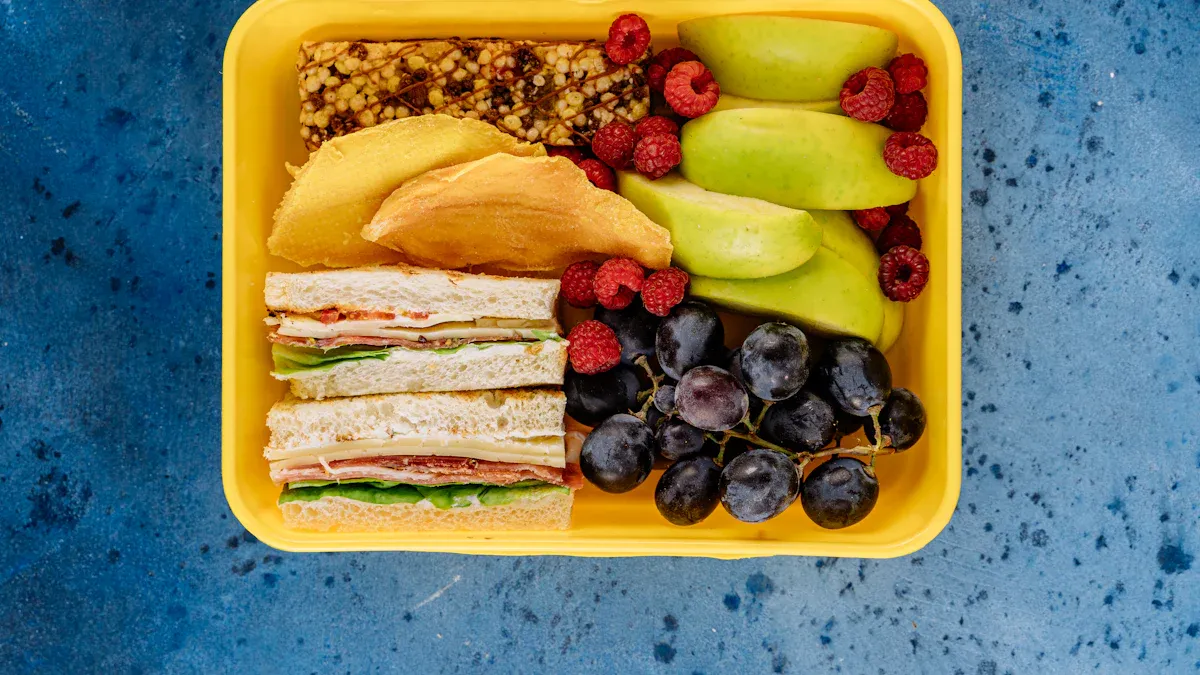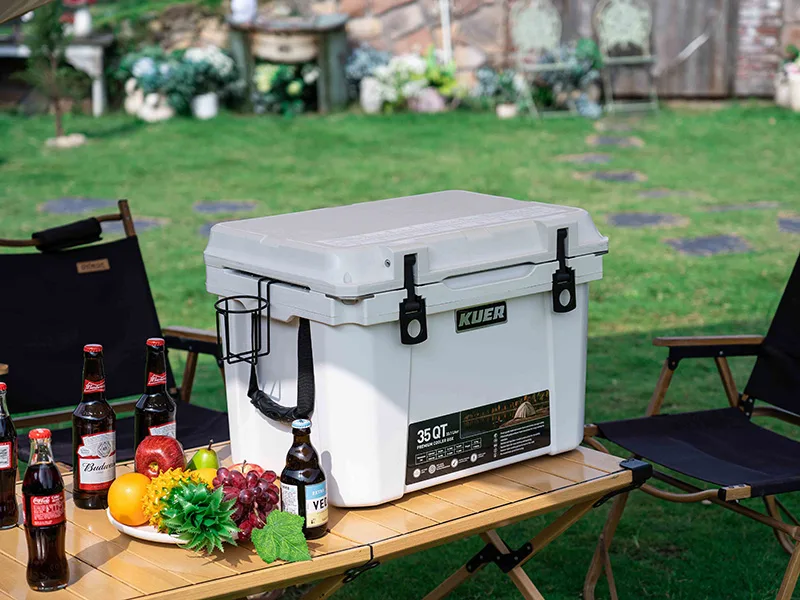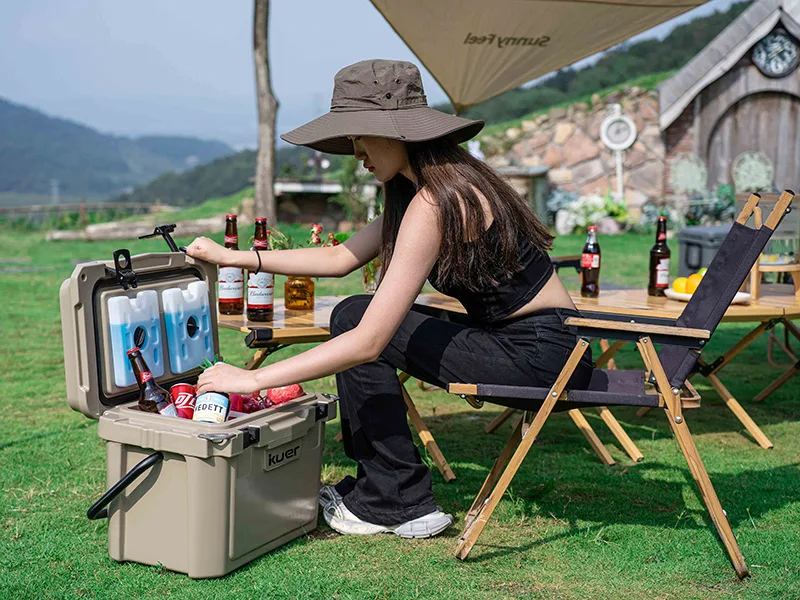

You want your lunch cooler bag small to stay fresh and last a long time. The best way to do that is to clean it after each use. When you care for your insulated cooler bag, you keep your food safe and your lunch bag smelling good. A clean insulated lunch bag means you enjoy every meal without worry. Remember, a little care goes a long way with your cooler bag.
Key Takeaways
- Clean your cooler bag after each use to keep it fresh and safe. This simple habit prevents bacteria and odors from building up.
- Perform a deep clean weekly using mild soap and warm water. This helps remove hidden dirt and germs, ensuring your food stays safe.
- Store your cooler bag in a dry, cool place to prevent mold and odors. Always let it air dry completely before putting it away.
- Pack your cooler bag smartly. Use ice packs at the bottom and avoid overloading to maintain cold temperatures and prevent damage.
- Inspect your cooler bag regularly for signs of wear. Early repairs can extend its lifespan and keep your food safe.
Clean It After Each Use: Daily and Weekly Care for Your Lunch Cooler Bag Small

Step-by-Step Daily Cleaning for Your Cooler Bag
You use your lunch cooler bag small every day, so it needs a quick clean after each use. This keeps your food safe and your bag smelling fresh. Here’s how you can make daily cleaning easy:
- Empty your cooler bag as soon as you get home. Don’t leave any crumbs or wrappers inside.
- Wipe up any spills right away. This stops sticky spots from turning into stains.
- Sprinkle a little baking soda inside the bag and let it sit overnight. Baking soda helps absorb odors.
- Place a dryer sheet or a few sprigs of mint or rosemary inside to keep things smelling nice.
- Leave the bag unzipped and open to air out before you store it.
- Drop in a small silica packet to soak up any leftover moisture.
Tip: If you clean out your lunch bag every day, you stop bacteria from building up. This simple habit keeps your cooler bag fresh and safe for your next meal.
Weekly Deep Clean Routine for Insulated Cooler Bag
Even if you wipe down your cooler bag daily, it still needs a deeper clean once a week. This helps remove any hidden dirt or germs. Here’s a simple weekly routine:
- Take everything out of your insulated cooler bag.
- Mix a little mild soap with warm water.
- Use a soft cloth or sponge to wipe down the inside and outside of the bag.
- Pay extra attention to seams and corners where crumbs can hide.
- Rinse with a clean, damp cloth to remove any soap.
- Let the bag dry completely with the zipper open.
Cleaning experts say you should clean regularly to stop bacteria and odors from building up. A 2017 study found that 73% of school lunchboxes have high levels of bacteria. These germs can cause health problems like migraines, coughs, and even asthma. When you clean your cooler bag each week, you help keep your food safe and your bag in top shape.
Cleaning Tips for KUER and Other Insulated Cooler Bags
Cooler bags come in many materials. Each one needs a little different care. Here’s a quick guide to help you clean your bag the right way:
| Material | Cleaning and Maintenance Impact |
|---|---|
| Polyester or Nylon | Easy to clean, often machine washable |
| Foam Insulation | Wipe clean, may hold odors |
| Aluminum Lining | Wipe clean, resists moisture |
| Cotton and Linen | Needs gentle cleaning, air dry |
| Neoprene | Easy to clean, often machine washable |
| High-Density Oxford Fabric | Water-resistant, easy to clean |
| Silicone | Dishwasher safe, very easy to clean |
| Aluminum Foil | Wipe clean, light and recyclable |
KUER insulated cooler bags use strong, easy-to-clean materials like high-density Oxford fabric and aluminum lining. These materials make cleaning simple. Just wipe them down with a damp cloth and let them dry. If your bag has foam insulation, check for any lingering smells and use baking soda or fresh herbs to keep it fresh.
Note: Always check the care label on your cooler bag before washing. Some bags can go in the washing machine, but others need hand washing.
When you follow these cleaning steps, your cooler bag stays fresh and ready for every lunch. You protect your health and make your bag last longer.
Proper Storage for Your Lunch Cooler Bag Small
Where to Store Your Cooler Bag
You want your lunch cooler bag small to last a long time. Storing it in the right spot makes a big difference. Pick a place that is clean, dry, and easy to reach. You can store it in a safe place like a kitchen cabinet, pantry shelf, or even your office drawer. Make sure the spot is away from direct sunlight and heat. Sunlight can fade the colors and weaken the materials.
Here are some best practices for storing your cooler bag at home or work:
- Clean your lunch bag with hot soapy water after each use.
- Let it air dry before you put it away.
- Use at least two cold sources, like ice packs or frozen water bottles, to keep food safe.
- Choose an insulated lunch bag to help keep your food fresh until lunchtime.
If you store properly, you keep your cooler bag ready for the next meal. You also help prevent bacteria and fungus from growing inside.
How to Store to Prevent Odors and Mold
Odors and mold can sneak up on your cooler bag if you do not store it the right way. Moisture is the main problem. If you put your bag away while it is still wet, you might notice a musty smell later. Mold and fungus love damp places. They can grow fast and make your bag smell bad.
Check out this table to see how improper storage can cause problems:
| Factor | Explanation |
|---|---|
| Improper Storage | Storing a cooler bag while it’s still wet or closed for too long can cause musty odors. |
| Moisture | Dampness helps bacteria and fungus grow, leading to bad smells. |
| Keep It Dry | Always dry your bag before you store it to stop mold and mildew. |
You can stop odors by cleaning your cooler bag often. Use a mild soapy solution and a damp cloth to wipe away food bits. Make sure you clean both the inside and outside. Some lunch bags have antimicrobial protection to fight odor-causing bacteria. If you let your bag air out and dry fully, you keep it fresh and ready for use.
Tip: Place your lunch cooler bag small and ice packs in the freezer overnight before use. This helps keep everything cold and fresh the next day.
Smart Packing Tips for Insulated Cooler Bag

Avoid Overloading Your Lunch Cooler Bag Small
You want your lunch cooler bag small to work its best every day. When you pack too much inside, you make it harder for cold air to move around. This can lead to warm spots and food that does not stay fresh. Overloading also puts extra stress on the seams and fabric. You might notice the bag wearing out faster or even getting small tears.
Here are some common mistakes and how to fix them:
| Mistake | Fix |
|---|---|
| Packing room temperature items | Pre-chill all food and drinks before packing. |
| Randomly throwing items into the bag last-minute | Pack in a structured way—ice on the bottom, food in the middle, more ice on top. |
| Opening the bag too frequently | Place items you use most near the top or edge. |
| Skipping the pre-chill step for the bag itself | Pre-chill the cooler bag for at least an hour before use. |
| Underfilling or overstuffing the bag | Pack it snug but not tight. Fill empty spaces with towels or cloth. |
Tip: Don’t overload the bag. A well-packed cooler bag keeps your food cold and helps your bag last longer.
Using Ice Packs the Right Way in Your Cooler Bag
Ice packs play a big role in keeping your lunch cold. You want to use them the smart way for the best results. Always place ice packs or gel packs at the bottom of your insulated cooler bag. This helps cold air move up and around your food. Layer your cold items on top of the ice packs. Try not to pack too tightly, so cold air can flow.
| Tip | Description |
|---|---|
| Ice Packs | Use ice packs or gel packs at the bottom for longer-lasting coolness. |
| Layering | Place cold items on top of ice packs. Leave space for air to circulate. |
| Organize | Group similar items together. Use dividers if needed to keep things in place. |
Note: If you pre-chill your lunch bag and your food, your cooler bag will keep things cold even longer.
Separating Food and Drinks in Your Insulated Cooler Bag
You can keep your food fresh and your drinks cool by packing them in separate sections. Drinks often sweat and can make sandwiches or snacks soggy. Use small containers or bags to keep wet and dry items apart. Place drinks near the ice packs and food in the middle or top. This way, you keep everything at the right temperature and avoid leaks.
- Use reusable containers for snacks and sandwiches.
- Put drinks in a separate pocket or at the bottom.
- Keep napkins and dry snacks away from cold, wet items.
Packing your insulated cooler bag with care helps you enjoy fresh, tasty meals every day. You protect the quality of your lunch and make cleaning easier, too.
Handling and Care for Your Insulated Cooler Bag
Gentle Use Every Day
You want your cooler bag to last and keep your food safe. The best way to do this is to handle with care every single day. When you pick up your insulated cooler bag, use the straps or handles instead of grabbing the sides. This helps keep the seams strong and the insulation working well. If you have kids at home, keep it out of reach so they don’t play with it or accidentally damage it.
Many cooler bags use tough materials like polyester and nylon. These fabrics stand up to daily use and resist wear and tear. Polyester feels lightweight and easy to clean. Nylon gives you extra strength and holds up in rough conditions. Even with these strong materials, you still need to treat your bag gently. If you toss it around or drag it on the ground, you might see scuffs or small tears over time.
Zippers need special attention. Use the zippers carefully and make sure there’s nothing caught in them before you close your bag. Dirt or crumbs can get stuck and make the zipper hard to open or close. If you force it, the zipper might break. A broken zipper means your bag won’t close right, and your food might not stay cold.
Tip: Wipe the zipper area with a damp cloth once a week. This keeps it clean and working smoothly.
Avoiding Sharp or Heavy Objects in Your Cooler Bag
You want your insulated cooler bag to keep its quality for a long time. That means you don’t put sharp objects inside. Knives, forks, or even pointy snacks can poke holes in the lining. Holes let cold air escape and make your bag less effective. If you need to bring utensils, use a separate case or wrap them in a napkin.
Also, don’t pack it with heavy objects. Overloading your bag with big water bottles or heavy containers can stretch the fabric and strain the seams. This can lead to rips or make the insulation less effective. When you pack your lunch, choose lighter items and spread the weight evenly.
Here’s a quick table to help you remember what to avoid:
| What to Avoid | Why It Matters |
|---|---|
| Sharp objects | Can puncture the lining |
| Heavy items | May stretch or tear the fabric |
| Overloading | Reduces insulation and causes damage |
Taking a little extra care each day helps your cooler bag stay in great shape. You get better performance and a longer life from your bag.
Inspecting for Damage in Your Lunch Cooler Bag Small
What to Look For in Your Insulated Cooler Bag
You want your insulated cooler bag to stay in the best shape possible. Regular checks help you spot problems early. Most manufacturers suggest you inspect your lunch cooler bag small every 3-6 months. This habit helps you catch small issues before they turn into big ones.
Here are some common signs of wear you should look for:
- Frayed stitching or torn seams
- Cracks in the insulation or lining
- Worn zippers and straps
If you notice any of these, take action right away. Early repairs can help you prolong the lifespan of your cooler bag and keep your food safe.
Tip: Make a quick checklist and mark your calendar for a bag check every few months. This keeps your cooler bag in top condition.
Fixing Minor Issues in Your Cooler Bag
You can fix many small problems yourself and extend its life. If you see a small tear, grab a patch kit. Clean the area, apply the adhesive, and press the patch on firmly. Let it dry before you use the bag again. For fabric rips, fabric glue or a few small stitches with heavy-duty thread work well.
Zipper problems are common. If your zipper feels stuck, try a silicone-based lubricant. Sometimes, you just need to replace the zipper pull. If the zipper is too damaged, you might need a new one. For loose or broken handles, sew them back on with strong thread or ask a professional for help.
Here’s a quick list to guide you:
- Use a patch kit for small tears after cleaning the area.
- Try fabric glue or sew small rips.
- Apply lubricant to zippers or replace them if needed.
- Repair handles with heavy-duty thread.
Taking care of these minor issues keeps your cooler bag’s quality high and helps you get the most out of it. A little attention now means your bag will last longer and stay ready for every meal.
Quick Dos and Don’ts to Care for Your Insulated Cooler Bag
Dos for Everyday Maintenance of Your Cooler Bag
You want your insulated cooler bag to last and keep your food safe. Following a few simple care instructions every day makes a big difference. Here are the top things you should do:
- Clean your bag after each use. Use soap and warm water, then let it air dry all the way. This keeps your bag fresh and ready for tomorrow.
- Store your cooler bag in a safe spot. Pick a dry, cool place, somewhere between 50 and 85 degrees. This helps the materials stay strong.
- Keep your bag out of reach in busy areas. If you protect it from bumps and spills, you avoid damage.
- Use the zippers gently. Open and close them with care, and keep them free of crumbs or dirt.
Tip: A little daily care goes a long way. You’ll notice your bag stays cleaner and works better for longer.
Don’ts to Avoid Damage to Your Lunch Cooler Bag Small
You want to avoid mistakes that can ruin your lunch cooler bag small. Here are some things you should never do:
- Don’t put sharp objects inside. Knives or forks can poke holes in the insulation.
- Don’t pack heavy items that could break the bag or cause leaks.
- Stay away from overloading. Too much stuff can damage the zippers and seams.
- Don’t throw your bag around or forget to clean it after use.
If you follow these dos and don’ts, you keep your cooler bag in great shape. You also make sure your food stays safe and cool every day.
You keep your lunch cooler bag small fresh and safe when you clean it after each use, store it in a dry spot, pack smart, handle gently, and check for damage. These habits help your lunch bag last longer and protect your meals.
- Cooler bags maintain safe temperatures, stopping bacteria and keeping food fresh.
- Proper care extends the lifespan and reduces waste, which helps the environment.
| Product Type | Average Lifespan (Years) | With Proper Maintenance | Without Maintenance |
|---|---|---|---|
| Insulated Bags | 2-4 | Extended Usability | Shorter Lifespan |
Consistent care means you enjoy tasty, healthy lunches every day.
FAQ
How often should you clean your lunch cooler bag small?
You should clean your cooler bag after every use. Wipe it down daily and do a deeper clean once a week. This keeps your bag fresh and helps prevent odors or bacteria.
Can you put your insulated cooler bag in the washing machine?
Always check the care label first. Some cooler bags are machine washable, but many need hand washing. If you’re unsure, stick with a gentle hand wash to protect the materials.
What’s the best way to get rid of odors in your cooler bag?
Try these quick fixes:
- Sprinkle baking soda inside and let it sit overnight.
- Place a dryer sheet or a few mint leaves inside.
- Air out your bag with the zipper open.
How do you keep your cooler bag from getting moldy?
| Step | Why It Works |
|---|---|
| Dry completely | Stops mold from growing |
| Store open | Lets air flow inside |
| Clean often | Removes food and moisture |
Keep your bag dry and clean to avoid mold.




